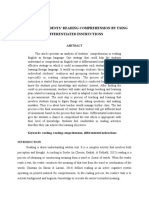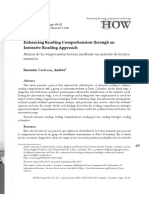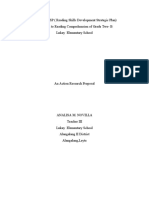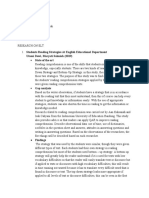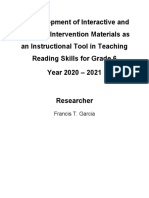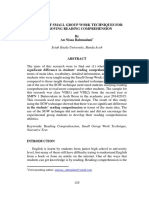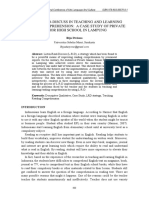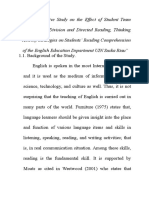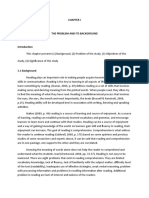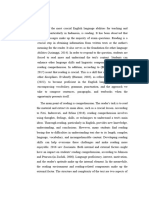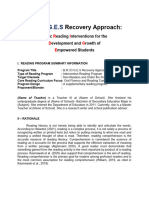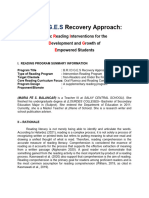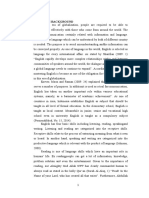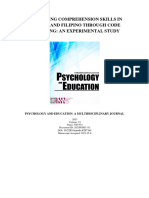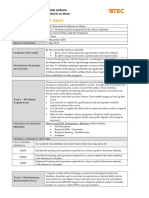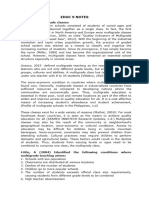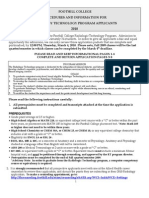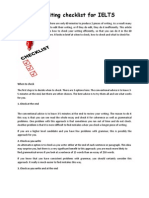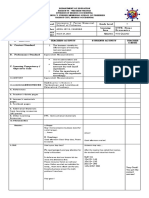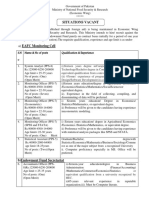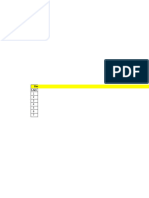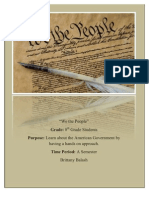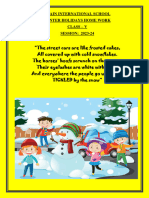Reading Comprehension
Uploaded by
Klint Cj LurizReading Comprehension
Uploaded by
Klint Cj LurizChapter 1
INTRODUCTION
Background of the Study
Reading is a vital and priceless activity. The ability to read and understand texts is
crucial to a child's success in school and throughout life. Good books can have a positive
impact on your life and guide you in the right direction. Reading will help you develop your
imagination and provide you with a wealth of knowledge. A fluent reader can read smoothly,
which is important for a person's positive growth and development.
To teach a student to read fluently without consciously thinking about it, the skill
must be taught systematically and explicitly, at the appropriate time and sequence. Word
recognition, phonological awareness, decoding, and sight recognition are the areas where
readers require the most assistance. Without this knowledge, the reader's fluency slows, and
their comprehension of the information being read suffers. These abilities must be taught in
order to become automatic. (Bengeny, 2010).
Many educators believe that learning to decode requires phonemic awareness and letter
knowledge. A student's inability to identify and blend the sounds in a word to form the word's
pronunciation may result in multiple attempts to pronounce unknown words, slowing the
student's speed and comprehension. Students who struggle to read frequently struggle to
achieve fluency in word and passage reading. Fluency has been identified as an important
component of successful reading. As a result, in order to properly comprehend the text they
are reading, a student must develop automatism. (Spencer & Manis, 2012).
Furthermore, several fluency-based strategies have been reported to improve students'
reading abilities. Repeated reading is the most effective strategy for assisting students who
have difficulty with fluency and comprehension. The repeated reading assignment required
the student to reread a short passage a certain number of times or until a certain criterion was
met. (Samuels, 2014).
Thus, the researchers would like to determine the reading comprehension of Grade
8 SPED-C and BEP-G of Tupi National High School: Basis for Grafting Big Book as
Supplementary Material and be able to make some interventions in order to improve their
reading skills.
Statement of the Problem
This study aimed to determine the reading comprehension level of students
particularly to the Grade 8 SPED-C and BEP-G of Tupi National High School.
Specifically, this study seeks to answer the following questions:
1. What is the demographic profile of the Grade 8 SPED-C and BEP-G students in
terms of:
1.1 age,
1.2 gender,
1.3 ethnicity; and
1.4 last school attended?
2. What is the reading comprehension level of Grade 8 SPED-C and BEP-G students?
3. What intervention plan/program be proposed o address the problem?
Significance of the Study
This study will be significant to the students in encouraging them to value the
importance of reading as well as to improve their reading comprehension and to the people
around the community who are responsive about this study.
Parents This study can provide them with more knowledge and information
about how teachers of their children attempted to distribute their time
in order to improve the quality of their instructional time. Also, for
them to guide their children's studies.
Peers The peers will help the respondents to encourage their relatives or
friends not to give up knowing what type of modules they excel the
most and the least in order for them to accept how far their capacity
are.
Researcher The researchers will assist the respondents in learning everything
they can about their reading comprehension research. Also, to
provide them with additional literature that would serve as a
foundation for future studies based on the variables of the study.
Students Students will benefit the most from this study because it will teach
students the value of reading comprehension and help them improve
their reading skills. It is also expected to increase motivation to learn
English and rekindle self-confidence to improve reading
comprehension.
Teachers This study can give them more knowledge and information so that
they can promote the development of reading skills by providing
direct and explicit reading instruction that builds student mastery
through scaffolded instruction and incorporates universal design for
learning principles.
Definition of Terms
The following words were used in the study. To fully understand and clarify the
words in the study were defined conceptually and operationally.
BEP Students Operationally They are intended to meet basic
learning needs which provides the foundation on
which subsequent learning can be based.
Big Book Conceptually defined as a written material intended
to be read (Linde, 2017). Operationally defined as a
worksheet, instructions, and reading materials
prepared by the researchers.
Oral Reading Test Conceptually defined as a test used to quick
determine a student’s general reading level (Fry,
2013). Operationally defined as a test material in
which it will be read by the students.
Reading Comprehension Conceptually defined as the process in which
Information from the text and knowledge by the
reader act together to construct a meaning
(Kimberly, 2014). Operationally defined as using a
variety of reading strategies before, during, and after
a reading passage.
Reading Fluency Conceptually defined as the ability to read
accurately, smoothly and with expression (Hoffman,
2012). Operationally defines as how you can
recognize words automatically.
SPED Students Operationally and conceptually defined as a person
who enrolled to the school and a person who has a
disability.
Chapter 2
REVIEW OF RELATED LITERATURE AND STUDIES
This chapter provides an overview of previous research on knowledge sharing and
intranets. This Includes Related Literature, Related Studies, Foreign Studies, Local Studies,
Research Gap Analysis, Theoretical Framework, Conceptual Framework.
Related Literature
Over the past decade, the literary education has seen a major shift in fluency’s role in
the literacy curriculum, moving from rarely encountered instructional component to one that
is often responsible for diving major instructional decisions. This shift is due, in part, to the
identification of fluency as one of the areas reviewed by National Reading Panel. According
to Fawson and Smith (2008) that it results from a border reconsideration of the role of oral
reading in development of skilled reading.
Moreover, Javed et al. (2015) conducted an exploratory study to develop Reading
Comprehension Modules to support ESL coaches in implementing effective reading abilities
of ESL learners to enhance the level of comprehension. In this instance, the findings indicated
that reading activities integrated with inferential and reorganization questions can help
students in enhancing their level of reading comprehension as it associates with the
prevalence of challenge and engagement in reading activity.
Swan (2015) determined the efficacy of reading strategies in improving
comprehension, and provided evidence that active learners tend to have a lower level of
performance in reading comprehension followed by pre- and- rereading activities based on
keyword strategy in reading, whereas visual, sensitive, and sequential learners performed in
this reading strategy. In this instance, Swan (2015) suggested that keyword strategy should be
integrated with reading strategy to enhance the extent of comprehension in students.
Similarly, Ness (2016) has enlightened the context of strategies that promote effective
reading in students and their effect on enhancing their level of reading comprehension, and
the findings suggest that teachers should adopt explicit teaching style in reading
comprehension during reading activities. Rastegar et al. (2017) have implied that
metacognitive reading strategies; mainly comprising of thinking about text and character,
rereading, intuitive pause during reading, notes taking and underlining important information
in text helps the students to engage in effective comprehension.
Ismail et al. (2015) proved that smart and apt reading strategies; that are mainly
comprised of inferences, reorganization and literal comprehension are highly effective in
improving comprehension in students. Moreover, these strategies are also found to increase
the motivation level of learners to engage in reading activity. Hence, pre-reading activities in
integration with smart and apt strategies can help low-achiever learners to practice and learn
comprehension in an effective manner. Moreover, Mousavian and Siahpoosh (2018)
enlightened the efficacy of pre-teaching vocabulary pre-questioning strategy to enhance
reading comprehension; and proved that effective reading strategies are an effective means to
support students in their academics’ students provided with effective reading strategies
outperformed the students who were not provided with any pre reading strategy during
comprehension activities.
This study was aimed at investigating whether or not there was a significant effect of
the implementation of Big Book as media on reading comprehension achievement of the fifth-
grade students. This study was conducted in SD Laboratorium Undiksha Singaraja in the form
of an experimental research with post-Test only Control Group Design. The population was
the fifth grade in which two classes were selected as the sample of the study. Then, the
samples were decided as the experimental group and control group by using lottery. The
experimental group was taught by using Big Book as media and the control group was taught
by using conventional media. The data were analyzed by using t-test through SPSS 17.0. The
result of the data analysis showed that students in experimental group performed better than
the students in the control group. It was proven by the result of the descriptive statistics that
showed the mean score of the experimental group was 85.51 while the mean score of the
control group was 75.56. The result of the t-test also showed that the value of Sig (2-tailed)
0.000 was less than 0.05. It can be concluded that there was a significant difference of reading
comprehension achievement between students treated with big book as media and those
treated using conventional media at fifth grade of elementary school in SD Laboratorium
Undiksha Singaraja.
Teaching reading comprehension for young learners becomes a challenge for English
teachers in Indonesia. Dealing with that problem, this study had a purpose to investigate
whether there was any significant effect on students’ reading comprehension taught by using
big book and conventional media or not. Post-test only control group was used as the design
with fourth grade students of SD Laboratorium Undiksha Singaraja as the population. The
data were analyzed descriptively and inferentially. As the result, it can be concluded that big
book gives significant effect on students reading comprehension compared with the control
group. It can be proven from the difference of mean score gained by experimental group
(83.56) and control group (76.19). The result of the t-test also shows that the t-observed
exceeded the t-critical value (4.088> 2.042).
This research aimed find out the effectiveness of using big story book project (BSBP)
in teaching reading comprehension and to know the advantages and the disadvantages of
using BSBP in teaching reading comprehension. The researcher applied pre-experimental
research design and consists of pre-test, treatment and post-test in order to find whether the
big story book project (BSBP) effective in teaching reading comprehension. The instruments
used in this research were reading test and questionnaire. The result from this research shows
that using big story book project (BSBP) in teaching reading comprehension is effective. It is
proved by the result that there is significant difference between the result of the students’
mean score in the pretest and the post-test. In the pre-test, the students’ mean score is (43.79)
and in the post-test is (80.37). Furthermore, it is proved by the probability value is smaller
than α (0.00< 0.05). On the other word, BSBP has advantages to the students if applied in
teaching and learning process, especially in reading subject.
Problems at the initial reading stage must be overcome so that students do not have
difficulty in reading. Efforts are made to overcome the problem of reading at the beginning of
grade I elementary school students by using big book learning media. This research aims to
know:(1) the use of the big book in reading learning begins. (2) student learning outcomes by
using big books in initial reading activities in Karangpatihan 3 Elementary School. This
research is qualitative research with a type of descriptive research. The study subjects were
students of class I SDN 3 Karangpatihan, totaling 23 people. Data collection techniques in the
form of tests and observations. The results showed an average score at the pretests of 75.43
and post-tests 80.65. Post-test results showed 13 students in the good category at 56.52% and
10 students in the good category with a percentage of 43.48%. Thus, it can be concluded that
the use of Big Book media positively influences the ability to read the beginning in 1 st-grade
students in Karangpatihan 3 Elementary School.
Since big book becomes one kind of tools which can facilitate students'
comprehension during reading stories activities conducted by teachers, this study aimed to
know the implementation of Big Book in improving students' reading comprehension of the
sixth-grade students. Descriptive Qualitative was used with the sixth-grade students as the
subject in this study. The instruments used in this study were a video recorder, teacher's diary,
and interview guide. The data were collected through observations and interviews. The result
of this study showed that the implementation of Big Book was very helpful for improving
students' reading comprehension.
This study aims to determine the effect of using big book on students' reading
comprehension in class. This research used a quantitative approach. The research design was
a pre-experimental one-group pretest-posttest design. Data collection techniques using tests
and observations. The data analysis techniques were validity, reliability, normality,
homogeneity, t-test, and N-gain tests. The subjects of this study were 26 students of grade 8
SPED C consisting of 6 females and 20 males and 31 students of BEP G consisting of 4
females and 27 males.
This research is intended to know how well the use of Big Book in improving
student’s reading comprehension of the eight grade students of Tupi NHS. The purpose of this
research is to help students to cope with their problem in reading comprehension using Big
Book. Students can comprehend the reading text. This research will be classroom action
research which will be conducted on the purpose to solve the problem that happened in the
classroom action and to improve the teaching learning process. The data of classroom action
research were collected through achievement test, field note and observation checklist. This
research will implement three cycles, namely: planning, observing and reflecting. The use of
Big Book in improving students reading comprehension can be seen in every meeting or
cycles that was observed by the researcher and his/her collaborator.
The objective of this study was to investigate the effect of pre-questioning and
students’ perception on teaching media towards students’ reading comprehension in Tupi
National High School. The students were in the relevant grade (eight grade) during a period
of three months in which this study will conducted. Data collections were conducted by
taking the test and distributing questionnaires. The data were processed and analyzed by using
statistic descriptive, normality test, linearity test, Multicorrineality test, and hypotheses test.
Statistic test uses t test and F test. The research shows that there is an effect of students pre-
questioning and students’ perception on teaching media altogether towards reading
comprehension with the regression analysis: = 34, 89+ 0,408 X 1–0.056 X 2. Whenever there
is a rise in the value of pre-questioning, there will be a rise in the level of students’ reading
comprehension of 0,408 and whenever there is an increase in the value of student’s perception
on teaching media, there will be a decrease in students’ reading comprehension for 0,056.
The objectives in this research were to know the result of students reading
comprehension ability by using online newspaper and to find out whether the use online
newspaper effective or not for teaching news item text. Students were given pretest and post-
test reading to control and experimental group. The population of this research is the tenth-
grade students of SMA N 6 Purworejo in the academic year 2013/2014.the sample of this
research is class X-4 as control group that consist of 32, and X-5 as experimental group that
consist of 32 students.
This quantitative study was aimed to find out whether there is a significant effect on
students’ achievement after applying reading aloud technique for students’ reading
comprehension of the second grade at SMP Negeri 8 Banda Aceh. The pre-experimental
research with one group pre-test post-test design was undertaken to see achievement of the
use of reading aloud technique. This research utilized pre-test and post-tests to collect the
data. The class VIII-5 of junior high school was chosen as the sample in this study to receive
treatment for three meetings. The data was then analyzed by using independent t-test. The
calculation showed that the post-test score is 45 was higher than the pre-test ‘score, it was 36
with the significant standard 0.030< 0.05. The result of the research showed that Detail
Information and Vocabulary aspects were increased slightly after being taught by using
reading aloud technique. Although the improvement only on those two aspects of reading, it
is still recommended this technique to be used in teaching reading.
A difficult reading material has become one of the student problems in
comprehending the text. The application of using Authentic Reading Materials is needed for
students. This research aims to know the effectiveness of using Authentic Reading Materials
towards the students reading comprehension mastery. This experimental research used
quantitative method and queasy experimental design. The sample used in this research is
Thirty students as experimental class and Twenty students as control class. The researcher
will use purposive sampling as technique sampling. Based on the result of T test formula, t
ratio is 4, 61 and t table is 2, 44. It means that t count> t table. The result of this research will
indicate that using Authentic Reading Materials is effective towards the students reading
comprehension mastery at the Eight grade of SPED-C and BEP-G students of Tupi NHS.
Related Studies
Reading comprehension is one of the most complex behaviors in which humans
engage. Reading theorists have grappled with how to comprehensively and meaningfully
portray reading comprehension and many different theoretical models have been proposed in
recent decades (McNamara & Magliano, 2009; Perfetti & Stafura, 2014). These models range
from broad theoretical models depicting the relationships and interactions among
comprehension subcomponents to models of specific comprehension processes. We review
different frameworks and models that have significantly impacted theory development,
reading comprehension research, and instruction.
One framework, the Simple View of Reading (SVR), posits that reading
comprehension is the product of word decoding and linguistic comprehension (Gough &
Tunmer, 1986). Across many languages, research has shown that reading comprehension can
be explained by individual differences in these two components, though the relative
relationship of the components changes over time (Catts, 2018). Early in development,
decoding is more closely associated with reading comprehension than linguistic competence,
but once decoding is mastered, linguistic comprehension becomes a better predictor of
reading comprehension (e.g., Catts, Adlof, & Weismer, 2005). The SVR has been useful to
researchers and practitioners by providing a framework for understanding different profiles of
struggling readers including students who struggle primarily due to word-level problems (i.e.,
dyslexic), comprehension issues (i.e., poor comprehender), or both (i.e., garden variety poor
reader). As useful as the model has been, it does not explicate the subcomponents of language
or cognitive processes that underlie reading comprehension (Catts, 2018).
Foreign Studies
Examining the reading and cognitive profiles of students with significant reading
comprehension difficulties Philip Capin, Eunsoo Cho, Jeremy Miciak, Greg Roberts, Sharon
Vaughn Learning Disability Quarterly 44 (3), 183-196, 2021 This study investigated the word
reading and listening comprehension difficulties of fourth-grade students with significant
reading comprehension deficits and the cognitive difficulties that underlie these weaknesses.
Latent profile analysis was used to classify a sample of fourth-grade students (n = 446) who
scored below the 16th percentile on a measure of reading comprehension into subgroups
based on their performance in word reading (WR) and listening comprehension (LC). Three
latent profiles emerged: (a) moderate deficits in both WR and LC of similar severity (91%),
(b) severe deficit in WR paired with moderate LC deficit (5%), and (c) severe deficit in LC
with moderate WR difficulties (4%). Analyses examining the associations between cognitive
attributes and group membership indicated students with lower performance on cognitive
predictors were more likely to be in a severe subgroup. Implications for educators targeting
improved reading performance for upper elementary students with significant reading
difficulties were discussed.
Local Studies
Business leaders and education experts have largely recognized that education in the
Philippines has been facing a lot of difficulties, and the coronavirus pandemic has
exacerbated such difficulties as schools adopted distanced or ‘blended’ learning in the past
two years. The consensus has been that the Philippines — and the world in general — has
been facing a “learning crisis,” and it is hoped that the new administration will exert great
effort in resolving this another crisis in the country as face-to-face classes have resumed.
To recall, the most recent results of the Program for International Student Assessment
(PISA) conducted by the Organization for Economic Cooperation and Development (OECD)
showed that 15-year-old students in the Philippines scored lower in reading, mathematics, and
science than those in most of the countries and economies that participated in the survey back
in 2018.
The Philippines scored the lowest in reading comprehension with a mean score of 340
points, below the survey average of 487 points; while it was the second-lowest in Science at
357 and in Math at 353, below the average of 489 points in both subjects.
Interpreting the findings in context, OECD notes that expenditure per student in the
Philippines was the lowest amongst all PISA-participating countries, and the expenditure was
90% lower than the OECD average. “By comparison, expenditure per student in Indonesia
was 83% lower than the OECD average and students there outperformed students in the
Philippines, although their scores were still lower than those of students in between 66 and 70
other countries/economies,” the PISA report added.
The government should prioritize programs and interventions that would improve
Filipino learners’ proficiency in reading, amid the celebration of National Book Week from
Nov. 24 to 30, Sen. Sherwin Gatchalian (2022). The senator recalled that even before the
COVID-19 pandemic struck, international large-scale assessments showed that the country’s
learners were already struggling to meet the minimum required proficiency in reading.
“Reading is one of the foundations that we must strengthen in our youth and students. Now
we need to focus more on their reading, especially since the pandemic has worsened the
problem in our education sector.
In the 2018 Program for International Student Assessment (PISA), the Philippines
scored lowest in Reading out of 79 countries that participated. Results of the PISA further
showed that only one out of five Filipino learners aged 15 achieved at least the minimum
proficiency level in Overall Reading Literacy. Results of the 2019 Southeast Asia Primary
Learning Metrics, on the other hand, showed that only 10% of the country’s Grade 5 learners
achieved the minimum proficiency at the end of primary education. The World Bank also
estimated that as of June 2022, learning poverty in the Philippines is 90.9%. Learning poverty
is defined as the percentage of ten-year-old children who cannot read or understand a simple
story.
Research Gap Analysis
This study examined the reading and cognitive profiles of fourth-grade students with
significant reading comprehension difficulties. Latent profile analysis was used to classify a
sample of 446 students into three latent profiles: moderate deficits in both WR and LC of
similar severity (91%), severe deficit in WR paired with moderate LC deficit (5%), and
severe deficit in LC with moderate WR difficulties (4%). Implications for educators targeting
improved reading performance for upper elementary students with significant reading
difficulties were discussed. The most recent results of the Program for International Student
Assessment (PISA) conducted by the Organization for Economic Cooperation and
Development (OECD) showed that 15-year-old students in the Philippines scored lower in
reading, mathematics, and science than those in most of the countries and economies that
participated in the survey back in 2018. OECD notes that expenditure per student in the
Philippines was the lowest amongst all PISA-participating countries, and the expenditure was
90% lower than the OECD average. The government should prioritize programs and
interventions to improve Filipino learners’ proficiency in reading, as the pandemic has
worsened the problem in the education sector.
Theoretical Framework
Theories of Reading According to Vygotsky (1978), learning is a social process; thus,
classrooms must represent social places. The best classroom environment for struggling
readers is one where they can think and talk aloud with their classmates and the teacher about
their ideas and questions, (Tankersley, 2005, p.18).
It is not simply a matter of applying decoding conventions and grammatical
knowledge to the text. Good readers are able to relate text and their own background
knowledge efficiently. The schema theory relates primarily to comprehension, as learners
activate both knowledge of the reading topic, and knowledge of the way language works. For
example, as children read, they begin to develop an understanding of basic sentence structure,
which will help with decoding new texts. Jean Piaget's theory of cognitive development,
according to Sosnowski, may also be applied to the process of reading instruction. Piaget's
theory relies on the idea that learning is constructed by both the learner and the instructor. The
theory stresses assimilation of material and eventual equilibrium of the new material in the
learner's long-term memory.
The ‘Dual Route’ theory, developed in 2001, shows that as we read, we recognize
words that are already stored in our long-term memory but when we encounter new words,
we revert to the sounding out (phonological) strategy. As children develop their reading, they
access more and more words automatically. This aligns with cognitive load theory, which
proposes that there is a limit to how much information the working memory can hold at any
one time. Good readers who have automatic recognition of words stored in long term memory
can attend to comprehension, whilst poor readers who struggle with decoding and
comprehension might experience cognitive overload. The process of transferring knowledge
from short term memory to long term memory is one of repeated practice and rehearsal.
Whether automatic word recognition is a process of retrieving whole words from long term
memory or, a lightening-speed process of mapping sounds/letters, is unclear at present.
Conceptual Framework
The conceptual framework that will used is the Input- Process- Output (IPO) model.
The IPO model shows the process as series of boxes connected by inputs and outputs. The
first section is to survey the reading fluency of Grade8 SPED-C and BEP-G students using
big books that are adapted from an author. On the other side, the process that will be used is
through assessing the level of fluency of a student how fast or slow they read. And as a result,
it will determine the accurate type of big books that can be crafted for the students.
INPUT PROCESS OUTPUT
Phil-Iri results Retrieved data from the Crafting of Big Big
adviser survey. book as supplementary
Reading comprehension material
result
Figure 1 Paradigm of the Study
Chapter 3
RESEARCH METHODOLOGY
This chapter deals with the methods involved in study employed. This includes the
Research Design, Respondents of The Study, Sampling Procedure, Research Instrument, Data
Gathering Procedures, Locale Of The Study, Research Ethical Consideration.
Research Design
This chapter will be using the Evaluative-Developmental design. Data will be
gathered through self-made questionnaire about the Level of Reading Comprehension of
grade 8 SPED C and BEP G students of Tupi National High School.
Evaluative-Developmental supports innovation development to guide adaptation to
emergent and dynamic realities in complex environments. A complex system is characterized
by a large number of interacting and interdependent elements in which there is no central
control. Patterns of change emerge from rapid, real-time interactions that generate learning,
evolution, and development – if one is paying attention and knows how to observe and
capture the important and emergent patterns (Patton,2010)
Quantitative research uses methods that allow the measurement of the variables
within a collection of people of groups and resulting in data subjected to statistical analysis.
Quantitative research is conducted using collected statistical data in the form of surveys,
questionnaires, interviews, and experiments, which are designed to determine the opinion of
people of trends in the society (Witt, 2001)
Respondents of the Study
The respondents of this study will be the 8 SPED-C and BEP-G learners enrolled for
the school year 2022-2023. There are 64 students who were enrolled in these sections. they
are categorized as SPED C learners where they are part of the inclusive education who has
learning disabilities while BEP G learners were the product of two years distance learning
where they were categorized as non-readers.
Furthermore, the Teacher and admin will be Part of the research respondents.
Sampling Procedure
This study will use complete enumeration purposive sampling procedure, also known
as total population sampling technique. It is a non-probability technique which aims to select
samples based on characters of a population and the objective of the study. The researchers
used this sampling procedure since the population sample intended to be studied has been
identified as a single population. Specifically, 24 students of grade 8 SPED C and 40 students
of BEP G of Tupi National High School will be used as population sample. This sampling
method relies on the data collection from the population members who were conveniently
available to participate in the research. It involved getting the participants wherever the
researcher could find them and, typically, wherever was convenient (Saunders, Lewis &
Thornhill, 2012).
For the other respondents, such as the School Administrators, and SPED and BEP
Teachers the researcher will use complete enumeration as a sampling procedure.
Table 1 below displays the distribution of respondents.
Table 1
Distribution of Respondents
Respondents Number of Respondents
School Administrators 2
SPED and BEP Teachers 16
Total 18
SPED C Students 24
BEP G Students 40
Total Number of Respondents 82
Research Instrument
Questionnaire is one of the most widely used tools to collect data in especially social
science research. The main objective of the questionnaire in research is to obtain relevant
information in the most reliable and valid manner.
A 'questionnaire' is the instrument for collecting the primary data (Cohen, 2013).
'Primary data' by extension is data that would not otherwise exist if it were not for the
research process and is collected through both questionnaires or interviews, which we discuss
here today (O'Leary, 2014).
Data Gathering Procedures
Before the collection of the data needed for the study first, a letter asking the approval
of the school principal for the researcher to conduct the investigation was sent. Upon the
permission to do the research was granted, the researcher performed the following phases:
Phase I: Adopting the Phil IRI Test
First, the researcher will conduct a survey to know the total population of the
respondents of the study.
Phase II: Reproduction of Phil IRI Test
This study will employ the complete enumeration purposive sampling technique, also
known as total population sampling. It is a non-probability technique for selecting samples
based on population characteristics and the study's objectives. As the population sample to be
studied will be identified as a single population, the researchers will use this sampling
procedure. A population sample of 35 students from Tupi National High School's Grade 7
SPED C will be used.
Phase III: Conduct of the Study
The researchers will administer reading tests prepared by the researchers to Grade 8
SPED C and BEP G students at Tupi National High School.
Phase IV: Data Analysis
The researchers will examine the information gathered from the respondents. The
data that has been analyzed will be used to draw conclusions and make recommendations.
This conclusion can be used in the creation of a reading module.
Phase V. Crafting of Big Books
Locale of the Study
This study will be conducted in one of the public secondary school of the
municipality of Tupi, South Cotabato; Tupi National High School specifically in Junior High
School department. Tupi National High School is a public national high school established in
1966. Tupi National High School Have a Motto: Go Tupi NHS Students and Graduates, Take
the Lead! Tupi NHS is Established In 1966 The Tupi National High school changed its name
from Tupi Barangay High School when it was converted to a National High School in 1985
through Parliamentary Bill No. 5750. In 2009, its annex in Barangay Cebuano was separated
into an independent national high school called Cebuano National High school through
Republic Act 9767.
Research Ethical Considerations
Permission will be obtained from the School Administrator at Tupi National High
School to conduct this study on “The Level of Reading Comprehension of Grade 8 SPED C
and BEP G students of Tupi National High school: Basis for Grafting Big Book as
Supplementary Material” The consenting respondents participating in this will be at minimal
risk. However, participants will not be forced to do things against their will, participants will
be fully informed about the study’s purpose, procedures, potential risks and benefits, and
secure privacy and confidentiality of the study participants, Special care will be taken to
protect the rights and welfare of vulnerable populations, such as children, pregnant women,
and individuals with cognitive or mental disabilities, Steps will be taken to minimize harm to
study participants, both physical and psychological.
References
Bendak, L. (2018). Effects of Applying Repeated Readings Method, Reading
Fluency and Passage Comprehension of slow learners. World Family
Medicine.
Bengeny (2010). What is Reading Fluency? Retrieved from
https://studymoose.com/reading-fluency-essay
Dr. Kimberly (2014). 9 Definition of Reading Comprehension. Retrieved from
http://www.mathgenie.com/blog/importance-of-reading-comprehension
Fawson (2008). Aligning Theory and Assessment of Reading Fluency:
Automaticity, Prosody, and Definitions of Fluency. Retrieved from
https://www.research
gate.net/publication/292714107_Aligning_theory_and_assessment_of_readin
g fluency_Automaticity_prosody_and_definition_of_fluency
Fry, E. (2013). Informal Reading Assessments. Retrieved from
https://books.google.com/books/about/Informal_Reading_Assessments_by_D
r_Fry.html?id=h3eXHLRWdxsC
Linde (2017). What is Reading Module. Retrieved from
https://study.com/academy/lesson/what-is-a-reading-model-definition-
overview
Brad Hoffman (2012). What is reading fluency and Why it is important?
Retrieved from https://www.teachingchannel.org/blog/faws/03/31/wrting-
fluency
Pikulsi (2005). The importance of fluency. Retrieved from
https://www.research
gate.net/publication/292714107_Aligning_theory_and_assessment_of_readin
g fluency_Automaticity_prosody_and_definition_of_fluency
Samuels (1997). The Method of Repeated Reading. The Reading Teacher.
Retrieved from
https://www.tandfonline.com/doi/abs/10.1080/10573560802491190
Seels, (2013). Descriptive Developmental type 1. Retrieved from https://www-
researchgate-net.cdn.ampproject.org/v/s/www.researchgate.net/post/
What_do_we_mean_by_Descriptive_Research/amp?
You might also like
- Improving Students' Reading Comprehension by Using Differentiated InstructionsNo ratings yetImproving Students' Reading Comprehension by Using Differentiated Instructions7 pages
- The Level of Students Experiencing Difficulties in Reading and Understanding Among Senior High SchoolNo ratings yetThe Level of Students Experiencing Difficulties in Reading and Understanding Among Senior High School20 pages
- The Effect of Circ Strategy and Achievement Motivation Toward Students' Reading ComprehensionNo ratings yetThe Effect of Circ Strategy and Achievement Motivation Toward Students' Reading Comprehension12 pages
- Enhancing Reading Comprehension Through An Intensive Reading ApproachNo ratings yetEnhancing Reading Comprehension Through An Intensive Reading Approach14 pages
- The Effects of Comprehension Through Close ReadingNo ratings yetThe Effects of Comprehension Through Close Reading77 pages
- Ulfah Mariatul Kibtiah - 181230175 - UtseltNo ratings yetUlfah Mariatul Kibtiah - 181230175 - Utselt21 pages
- Reading Comprehension in Teaching English As A Foreign LanguageNo ratings yetReading Comprehension in Teaching English As A Foreign Language14 pages
- Development of Strategic and Interactive Intervention Materials As An Instructional Tool in Teaching Reading SkillsNo ratings yetDevelopment of Strategic and Interactive Intervention Materials As An Instructional Tool in Teaching Reading Skills10 pages
- An Analysis of Ability in Comprehending Reading Text of Seventh Semester Students at English Department of FBS Universitas Negeri PadangNo ratings yetAn Analysis of Ability in Comprehending Reading Text of Seventh Semester Students at English Department of FBS Universitas Negeri Padang6 pages
- Using KWL Strategy To Improve Students RNo ratings yetUsing KWL Strategy To Improve Students R10 pages
- Effective Practices For Teaching Reading StrategiesNo ratings yetEffective Practices For Teaching Reading Strategies17 pages
- Listen-Read-Discuss in Teaching and Learning Reading Comprehension: A Case Study of Private Senior High School in LampungNo ratings yetListen-Read-Discuss in Teaching and Learning Reading Comprehension: A Case Study of Private Senior High School in Lampung10 pages
- Examples F Backgroiund and Statement of ProblemsNo ratings yetExamples F Backgroiund and Statement of Problems17 pages
- 3 - The Impact of Questioning Strategy For Enhancing Eleventh Graders Reading Comprehension in EnglishNo ratings yet3 - The Impact of Questioning Strategy For Enhancing Eleventh Graders Reading Comprehension in English9 pages
- Impact of Explicit Teaching To The Comprehension Level of The PupilsNo ratings yetImpact of Explicit Teaching To The Comprehension Level of The Pupils14 pages
- Name: Jeclyn D. Filipinas First Year (New Curriculum) : EDDK-1A-NEW Professor: DR. JERSON S. CATOTONo ratings yetName: Jeclyn D. Filipinas First Year (New Curriculum) : EDDK-1A-NEW Professor: DR. JERSON S. CATOTO46 pages
- The Effects of Word Reading Skills To The Reading Comprehension of The Grade 7 StudentsNo ratings yetThe Effects of Word Reading Skills To The Reading Comprehension of The Grade 7 Students38 pages
- Atria Salsabila Nur 1847041002 Paper EspNo ratings yetAtria Salsabila Nur 1847041002 Paper Esp15 pages
- Project Rundle: Its Perceived Impact On Reading AchievementNo ratings yetProject Rundle: Its Perceived Impact On Reading Achievement6 pages
- ENHANCING-THE-READING-COMPREHENSION-SKILLS-IN-ENGLISH-OF-GRADE-11-STUDENTS-THROUGH-GUIDED-READING-SESSION100% (1)ENHANCING-THE-READING-COMPREHENSION-SKILLS-IN-ENGLISH-OF-GRADE-11-STUDENTS-THROUGH-GUIDED-READING-SESSION10 pages
- Intervention Reading Program - AshleyguinooNo ratings yetIntervention Reading Program - Ashleyguinoo19 pages
- Effect of Gate Pass of Bongabon Essential School Students English ComprehensionNo ratings yetEffect of Gate Pass of Bongabon Essential School Students English Comprehension9 pages
- (Article) Teachers Teachiques in Teaching Reading Comprehesnion at SMAN 1 Kota Sungai PenuhNo ratings yet(Article) Teachers Teachiques in Teaching Reading Comprehesnion at SMAN 1 Kota Sungai Penuh15 pages
- Developing Comprehension Skills in English and Filipino Through Code Switching: An Experimental StudyNo ratings yetDeveloping Comprehension Skills in English and Filipino Through Code Switching: An Experimental Study15 pages
- Pie Chart Di For Sbi Clerk Prelims Exam English and Hindi VersionNo ratings yetPie Chart Di For Sbi Clerk Prelims Exam English and Hindi Version21 pages
- Buhaynasapa National High School: Humanities and Social Sciences (Humss) StrandNo ratings yetBuhaynasapa National High School: Humanities and Social Sciences (Humss) Strand5 pages
- Unit 2 Btec Music Assignment Brief Chhs 2016No ratings yetUnit 2 Btec Music Assignment Brief Chhs 20162 pages
- Foothill College Procedures and Information For Radiology Technology Program ApplicantsNo ratings yetFoothill College Procedures and Information For Radiology Technology Program Applicants8 pages
- Input Data Sheet For E-Class Record: Region Division School NameNo ratings yetInput Data Sheet For E-Class Record: Region Division School Name54 pages
- St. Augustine University of Tanzania Jordan University College Library UnitsNo ratings yetSt. Augustine University of Tanzania Jordan University College Library Units19 pages
- Anesthesiology Residency Lists and DO Friendly50% (2)Anesthesiology Residency Lists and DO Friendly12 pages
- Situations Vacant: A) EAFC Monitoring CellNo ratings yetSituations Vacant: A) EAFC Monitoring Cell2 pages
- CCI Program AY 2023-2024 Application FormNo ratings yetCCI Program AY 2023-2024 Application Form8 pages
- The Common Sense of Differentiation PDFNo ratings yetThe Common Sense of Differentiation PDF222 pages
- Improving Students' Reading Comprehension by Using Differentiated InstructionsImproving Students' Reading Comprehension by Using Differentiated Instructions
- The Level of Students Experiencing Difficulties in Reading and Understanding Among Senior High SchoolThe Level of Students Experiencing Difficulties in Reading and Understanding Among Senior High School
- The Effect of Circ Strategy and Achievement Motivation Toward Students' Reading ComprehensionThe Effect of Circ Strategy and Achievement Motivation Toward Students' Reading Comprehension
- Enhancing Reading Comprehension Through An Intensive Reading ApproachEnhancing Reading Comprehension Through An Intensive Reading Approach
- The Effects of Comprehension Through Close ReadingThe Effects of Comprehension Through Close Reading
- Reading Comprehension in Teaching English As A Foreign LanguageReading Comprehension in Teaching English As A Foreign Language
- Development of Strategic and Interactive Intervention Materials As An Instructional Tool in Teaching Reading SkillsDevelopment of Strategic and Interactive Intervention Materials As An Instructional Tool in Teaching Reading Skills
- An Analysis of Ability in Comprehending Reading Text of Seventh Semester Students at English Department of FBS Universitas Negeri PadangAn Analysis of Ability in Comprehending Reading Text of Seventh Semester Students at English Department of FBS Universitas Negeri Padang
- Effective Practices For Teaching Reading StrategiesEffective Practices For Teaching Reading Strategies
- Listen-Read-Discuss in Teaching and Learning Reading Comprehension: A Case Study of Private Senior High School in LampungListen-Read-Discuss in Teaching and Learning Reading Comprehension: A Case Study of Private Senior High School in Lampung
- 3 - The Impact of Questioning Strategy For Enhancing Eleventh Graders Reading Comprehension in English3 - The Impact of Questioning Strategy For Enhancing Eleventh Graders Reading Comprehension in English
- Impact of Explicit Teaching To The Comprehension Level of The PupilsImpact of Explicit Teaching To The Comprehension Level of The Pupils
- Name: Jeclyn D. Filipinas First Year (New Curriculum) : EDDK-1A-NEW Professor: DR. JERSON S. CATOTOName: Jeclyn D. Filipinas First Year (New Curriculum) : EDDK-1A-NEW Professor: DR. JERSON S. CATOTO
- The Effects of Word Reading Skills To The Reading Comprehension of The Grade 7 StudentsThe Effects of Word Reading Skills To The Reading Comprehension of The Grade 7 Students
- Project Rundle: Its Perceived Impact On Reading AchievementProject Rundle: Its Perceived Impact On Reading Achievement
- ENHANCING-THE-READING-COMPREHENSION-SKILLS-IN-ENGLISH-OF-GRADE-11-STUDENTS-THROUGH-GUIDED-READING-SESSIONENHANCING-THE-READING-COMPREHENSION-SKILLS-IN-ENGLISH-OF-GRADE-11-STUDENTS-THROUGH-GUIDED-READING-SESSION
- Effect of Gate Pass of Bongabon Essential School Students English ComprehensionEffect of Gate Pass of Bongabon Essential School Students English Comprehension
- (Article) Teachers Teachiques in Teaching Reading Comprehesnion at SMAN 1 Kota Sungai Penuh(Article) Teachers Teachiques in Teaching Reading Comprehesnion at SMAN 1 Kota Sungai Penuh
- Developing Comprehension Skills in English and Filipino Through Code Switching: An Experimental StudyDeveloping Comprehension Skills in English and Filipino Through Code Switching: An Experimental Study
- Pie Chart Di For Sbi Clerk Prelims Exam English and Hindi VersionPie Chart Di For Sbi Clerk Prelims Exam English and Hindi Version
- Buhaynasapa National High School: Humanities and Social Sciences (Humss) StrandBuhaynasapa National High School: Humanities and Social Sciences (Humss) Strand
- Foothill College Procedures and Information For Radiology Technology Program ApplicantsFoothill College Procedures and Information For Radiology Technology Program Applicants
- Input Data Sheet For E-Class Record: Region Division School NameInput Data Sheet For E-Class Record: Region Division School Name
- St. Augustine University of Tanzania Jordan University College Library UnitsSt. Augustine University of Tanzania Jordan University College Library Units

